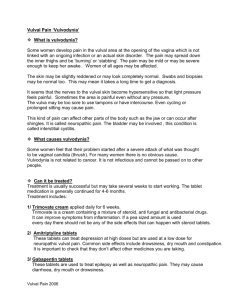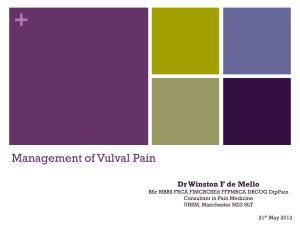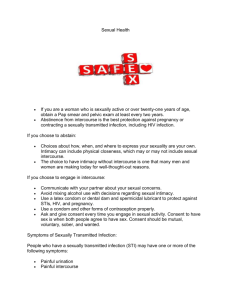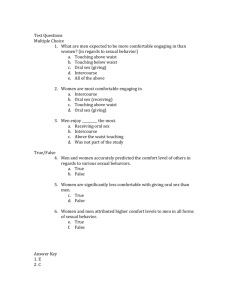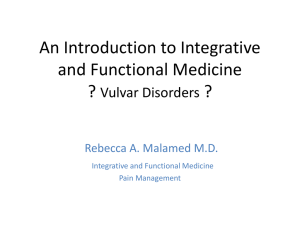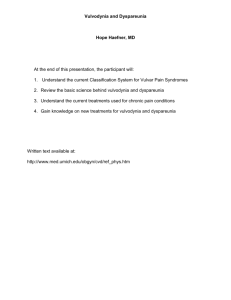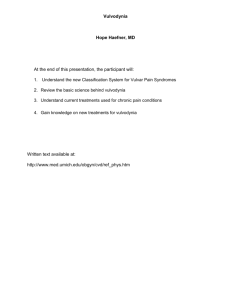Get this release in Word format
advertisement
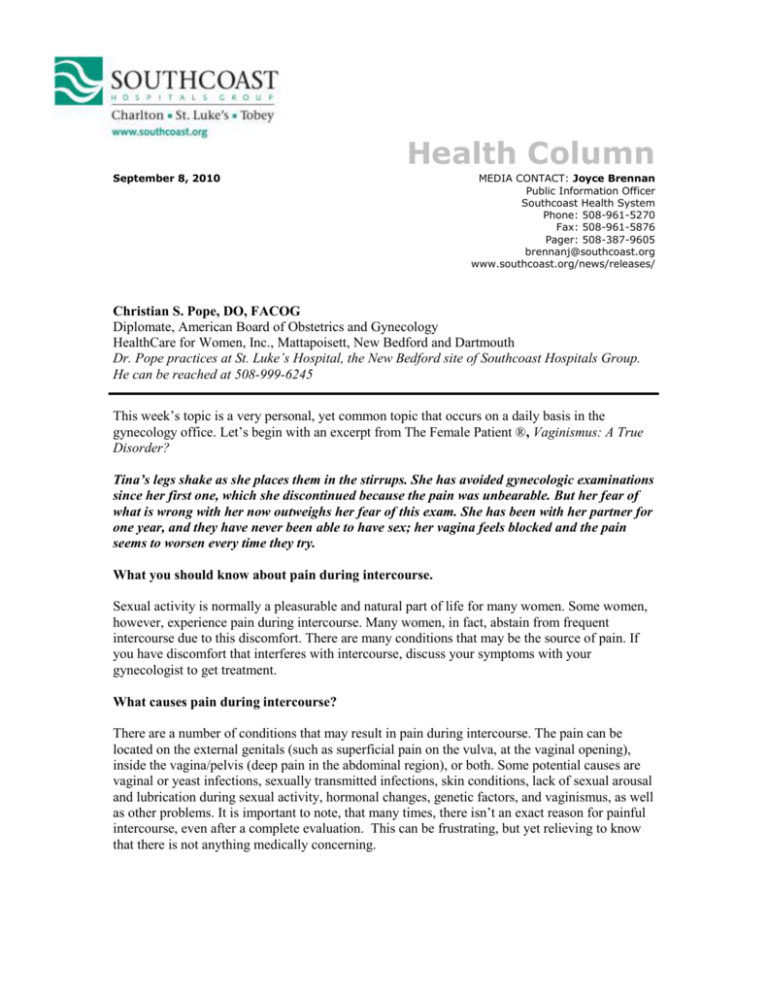
Health Column September 8, 2010 MEDIA CONTACT: Joyce Brennan Public Information Officer Southcoast Health System Phone: 508-961-5270 Fax: 508-961-5876 Pager: 508-387-9605 brennanj@southcoast.org www.southcoast.org/news/releases/ Christian S. Pope, DO, FACOG Diplomate, American Board of Obstetrics and Gynecology HealthCare for Women, Inc., Mattapoisett, New Bedford and Dartmouth Dr. Pope practices at St. Luke’s Hospital, the New Bedford site of Southcoast Hospitals Group. He can be reached at 508-999-6245 This week’s topic is a very personal, yet common topic that occurs on a daily basis in the gynecology office. Let’s begin with an excerpt from The Female Patient ®, Vaginismus: A True Disorder? Tina’s legs shake as she places them in the stirrups. She has avoided gynecologic examinations since her first one, which she discontinued because the pain was unbearable. But her fear of what is wrong with her now outweighs her fear of this exam. She has been with her partner for one year, and they have never been able to have sex; her vagina feels blocked and the pain seems to worsen every time they try. What you should know about pain during intercourse. Sexual activity is normally a pleasurable and natural part of life for many women. Some women, however, experience pain during intercourse. Many women, in fact, abstain from frequent intercourse due to this discomfort. There are many conditions that may be the source of pain. If you have discomfort that interferes with intercourse, discuss your symptoms with your gynecologist to get treatment. What causes pain during intercourse? There are a number of conditions that may result in pain during intercourse. The pain can be located on the external genitals (such as superficial pain on the vulva, at the vaginal opening), inside the vagina/pelvis (deep pain in the abdominal region), or both. Some potential causes are vaginal or yeast infections, sexually transmitted infections, skin conditions, lack of sexual arousal and lubrication during sexual activity, hormonal changes, genetic factors, and vaginismus, as well as other problems. It is important to note, that many times, there isn’t an exact reason for painful intercourse, even after a complete evaluation. This can be frustrating, but yet relieving to know that there is not anything medically concerning. Pain during intercourse may also be associated with certain chronic conditions such as endometriosis, irritable bowel syndrome, interstitial cystitis (painful bladder syndrome), and pelvic inflammatory disease. It is the most common symptom of “vulvodynia”. What is vulvodynia? Vulvodynia affects women of all age groups, beginning as early as adolescence. According to an National Institute of Health funded Harvard Medical School (Stewart, EG. JAMWA, 2003), almost 16 percent of women in the U.S. suffer from vulvodynia at some point during their lives, with more than 90 percent report ongoing pain for many years. Approximately six million women currently suffer from vulvodynia. The incidence of symptom onset is highest bet ween the ages of 18 and 25, and lowest after age 35.Once considered a condition that affects primarily Caucasian women, several recent studies have shown that African American and Hispanic women are equally likely to develop vulvodynia. Living with vulvodynia imposes serious limitations on a woman's ability to engage in normal daily activities. In many cases, the pain is so severe and unremitting that it forces women to resign from career positions, abstain completely from sexual relations and limit many physical activities, often destroying a woman's self-image. In addition, because genital disorders are not openly discussed, women with vulvodynia experience isolation and hopelessness. According to an National Institute of Health study funded by Robert Wood Johnson Medical School (Arnold LD. AJOG, 2007): 75 percent of women with vulvodynia feel “out of control” of their bodies 60 percent report that it compromises their ability to enjoy life 60 percent cannot have sexual intercourse because of the pain. Vulvodynia is superficial pain or discomfort that occurs in the absence of physical findings (that is, there is no infection or other physical problem to directly explain why pain is present). The pain can be provoked by pressure to the area (such as during sexual intercourse or tampon insertion) or it can be unprovoked (when there is no external trigger for the pain; it occurs spontaneously). The pain can also be localized to a certain area, like the vaginal opening, or generalized to the entire vulvar region. Unfortunately, because vulvodynia occurs in the absence of physical findings, some women are incorrectly told by a clinician that there is no cause for their pain, as no infection is present to explain their symptoms. This might lead women to believe their pain is not legitimate or that it is all in their head. Vulvodynia is a real pain condition, however, with many women across the life cycle reporting this condition. What is vaginismus? Women with vaginismus experience great difficulty with vaginal penetration, such as during gynecologic exams, tampon insertion, or sexual intercourse. In some cases, vaginal penetration has never been possible. Women with this condition tend to regularly experience pain during attempts at vaginal penetration and have tension in the pelvic floor muscles (those that control voiding of the bladder and bowels). Due to this difficulty, women with vaginismus experience a great deal of fear and anxiety about vaginal penetration, which may lead them to avoid such situations. Is there treatment for my pain? A patient with symptoms of vaginismus, such as the person mentioned in The Female Patient ® excerpt at the beginning of this article, must be approached with patience, understanding, and a gentle manner, as a negative and/or painful gynecologic examination experience may worsen the patient’s distress. The clinician and patient may need to meet several times beforehand. Your physician will discuss your symptoms with you and will perform a pelvic exam. Treatment options may include medications, biofeedback therapy, anesthetic ointment, behavioral exercises, and in some cases, and rarely, surgery. Some lifestyle remedies may be offered to relieve pain and itching. The treatment depends on the cause of the discomfort. If the diagnosis is not established, the treatment will be incorrect. Where can I find more information on pain during intercourse? Your clinician is a trusted and valuable source of information. In addition, some helpful websites are available from the National Vulvodynia Association (www.nva.org), the International Society for the Study of Vulvovaginal Disease (www.issvd.org), and www.vulvodynia.com. Have a Women’s Health topic you would like covered? Dr. Pope is happy to answer your questions or write a column on a topic you choose. Please send Women’s Health topic requests to Joyce Brennan at brennanj@southcoast.org. ###
